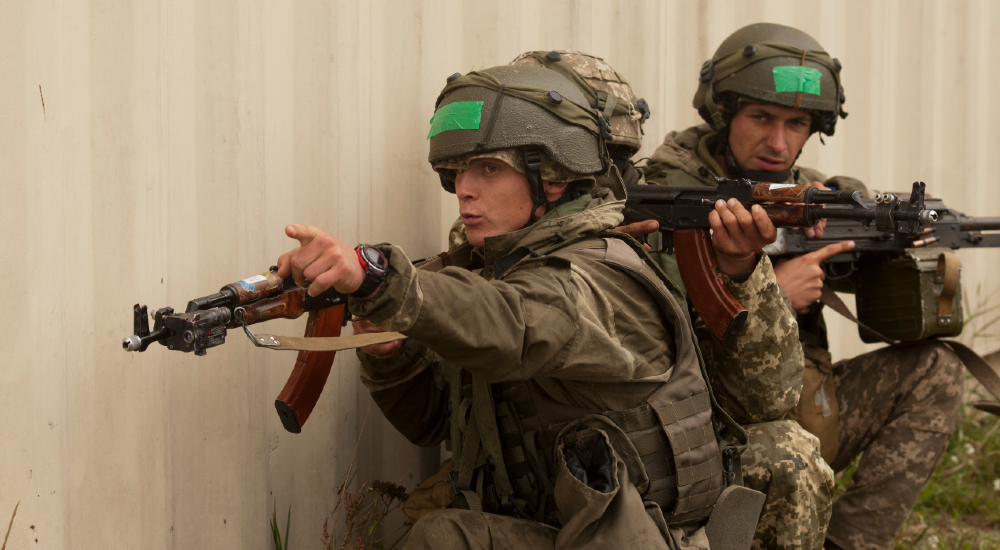Lessons From Ukraine for Security Force Assistance

Published by The Lawfare Institute
in Cooperation With

Editor’s Note: Why did security force assistance work in Ukraine but fail in Afghanistan? Alexandra Chinchilla of Texas A&M’s Bush School unpacks this question, examining the factors that led assistance to work—at least somewhat—in Ukraine and explaining the lessons we should learn about when and how to use this tool in the future.
Daniel Byman
***
Just over two years have passed since the fall of Kabul. The speed of the collapse and the chaos of the U.S. withdrawal was shocking, but the eventual outcome was less surprising. In my interviews with U.S. military advisers who served in Afghanistan, no one believed the Afghan government could hold off the Taliban long without U.S. support. Fresh from this failure, American observers were perhaps too pessimistic in February 2022 when Russian troops sat on the Belarusian border with Ukraine, just over a hundred miles north of Kyiv. U.S. intelligence warned that Russian troops might seize Kyiv and install a puppet government in a matter of days, leaving only a rump state in the West.
But that didn’t happen. Ukrainian security forces, along with thousands of civilians, halted the Russian advance outside of Kyiv. After Russia’s failed attempt at regime change, Western aid began pouring into Ukraine on an unprecedented scale. By the time I visited Washington, D.C., in May 2022, the U.S. government was patting itself on the back for training and arming Ukraine since Russia’s initial invasion in 2014. When asked what went right, a senior U.S. official told me and a small group of researchers, “We built a professional NCO [noncommissioned officer] corps.” It’s clear something worked in Ukraine that didn’t work in Afghanistan. But how much, and in what ways, did U.S. security force assistance before Russia’s full-scale invasion enable Ukraine’s defense?
Overall, as I’ve written elsewhere, Ukraine is a successful case of security force assistance. I’ve formed this assessment based on extensive qualitative research, including nearly 100 interviews with U.S. and allied officials and advisers involved in aiding Ukraine, as well as Ukrainian politicians, soldiers, and civil society. What worked, though, and how much it mattered—is complicated.
Following Russia’s initial incursion in 2014, the Western response was swift but limited. The Obama administration chose a training and advising mission, wary of escalating tensions with Russia. NATO allies followed suit. Training and advising had three lines of effort: (a) establishing a combat training center at Yavoriv, (b) building a special forces capability that would be NATO interoperable, and (c) advising Ukraine’s security sector on how to transform from a Soviet legacy system to one resembling a NATO member country.
The combat training center was a success but was too small to train the entire Ukrainian army. Most Ukrainian soldiers trained in their home stations. NATO doctrine did not become the standard for how Ukrainian officers planned operations nor for how the General Staff managed training. The second line of effort—building capable Ukrainian Special Operations Forces (SOF)—was a success. But when Russia invaded, these SOF were thrown into the fight alongside conventional forces and the resulting significant casualties degraded their capability. The third line of effort—the wholesale transformation of Ukraine’s security sector—was a Herculean task that remains unfinished. Institutional transformation on the scale required in Ukraine takes decades, not years. With this in mind, there are three key lessons to draw from the pre-2022 effort to develop Ukraine’s armed forces.
Training Is Easier Than Building
Ukraine shows that training, especially at the tactical level, is much easier than building new institutions or reforming existing ones. Advisers uniformly described the high motivation of the average Ukrainian soldier as well as the speed with which they learned. Transforming defense institutions from Soviet legacy to NATO aligned is a more difficult task by orders of magnitude. Desirable outcomes, like the transparent and competitive procurement of arms and military equipment, require monumental reform—as evidenced by the fact that the overhaul of Ukraine’s defense procurement system is only now underway. Advisers were rarely embedded in the Ministry of Defense or the General Staff, limiting their access and influence. Yet these advising efforts did see some important progress in key functional areas, such as strategic communication, cyber defense, and military medicine. In 2019, Ukraine changed its constitution to commit to becoming a European Union and NATO member. This permanent, strategic realignment was a major achievement given the clear public consensus against NATO membership before 2014. After consideration of Western advice, Ukraine created defense planning concepts as well as a variety of legislation (like the 2018 law making the minister of defense a civilian) to align its military with NATO standards. But some of the other areas frequently touted as successes—a professional NCO corps and decentralized command and control—were not fully realized by 2022.
Had Russia not invaded, the Ukrainian army would have likely been in a position by 2023 to independently run the NATO-built Yavoriv combat training center. In that sense, the mission of the Joint Multinational Training Group-Ukraine (JMTG-U) was nearly completed. At Yavoriv, more than 27,000 Ukrainian individual soldiers, then battalions, and finally entire brigades, practiced soldier skills and trained in NATO ways of fighting. British and Canadian advisers worked at other locations in Ukraine, as well as with the Ukrainian National Guard. It’s clear that these training efforts had a positive effect on the Ukrainian military, or at least on the skills of the individuals and units who trained there, which can be clearly measured by comparing their skills at the beginning and end of training. In a dramatic testament to its value, Russian air strikes destroyed the state-of-the-art simulation center at Yavoriv early in the invasion.
But Western training was limited in scale. Most Ukrainian soldiers did not have the opportunity to receive Western training. Broader efforts to reform the Ukrainian training and professional military education system never gained sufficient traction before 2022. Constrained by their small footprint in Ukraine and lacking sufficient buy-in from the General Staff, NATO allies were left hoping that success at Yavoriv would trickle down throughout the force.
In contrast, Ukrainian SOF became a force thoroughly different from the Soviet-legacy spetsnaz that Ukraine had in 2014. NATO allies were heavily involved in designing the qualification course to produce new operators and establishing a new Special Operations Command. Ukrainian SOF developed into a highly trained force of tactically proficient operators; two units even passed a demanding evaluation process to participate in the NATO Response Force.
But even here, NATO allies were better at training than building. Western SOF trainers excel at creating partner SOF in their image; the Iraqi Golden Division is a prime example. Partner SOF are usually eager to emulate their trainers, down to their Patagonia gear and doctrinal buzzwords, and become part of the “family.” Yet the operational and strategic-level institutions for Ukrainian SOF were less developed and received less training. When Russia invaded, Ukrainian SOF fought as commandos alongside conventional forces, or even as a disciplined backbone inside less experienced conventional units, which led to high attrition rates. On the one hand, this was by necessity to plug gaps in conventional forces. When I interviewed Ukrainian SOF, they said this was an operational necessity—with their country fighting for its survival, what were they supposed to do but fight? On the other hand, more developed institutions could have prevented this. Or NATO allies could have better anticipated this role and built commandos for Ukraine cheaply and at scale instead of with a highly specialized capability.
For future security force assistance efforts, it’s worth asking: Is building required to achieve the desired outcome? If yes, time and significant advising efforts at the working level must be matched with sustained attention at the political level to motivate the partner’s senior decision-makers to build. If U.S. policymakers lack time, political will, or the ability to provide advising capacity, they would be better off aiming for smaller wins that can be achieved through training.
Shared Goals Do Not Imply Shared Ideas About How to Achieve Them
Ukraine’s motivation to defend itself is well known. And Western partners supported Ukraine’s defense. Despite these shared goals, though, both parties often had divergent ideas about how to reach them in the 2014-2022 period I studied. One Ukrainian I interviewed described this tension as the difference between military reform and modernization. NATO wanted reform of the Ukrainian security sector along certain core values: democratic control and oversight, transparency, and interoperability, to name just a few. The Ukrainian Armed Forces, by contrast, wanted to modernize the military with updated equipment and better tactics to keep fighting Russia in the Donbas. Significant tension existed between these methods of immediate increases in combat effectiveness versus transforming the Ukrainian security sector into something wholly new and different.
NATO and its allies weren’t always right. Many Western recommendations, if implemented, would have left Ukraine worse off when Russia invaded. For example, a major NATO priority was the complete reorganization of the Security Service of Ukraine (SBU), an intelligence agency whose unique combination of law enforcement powers and paramilitaries that can operate on Ukrainian soil has proved critical to finding and neutralizing Russian spy networks. Downsizing the military would have had similar negative effects. Ukrainians involved in reform often felt frustrated with the recommendations of NATO and the plethora of international advisers, which they viewed as contradictory or too vague. Further complicating matters, many Ukrainians felt that reform solely for NATO had little utility because NATO had little intention of granting Ukraine membership prior to Russia’s full-scale invasion.
Security Force Assistance Might Not Always Be the Decisive Factor
Ukraine’s experience over the past 18 months shows that it is unrealistic to expect security force assistance to be the decisive factor in any conflict. In Ukraine, so many factors pulled in the direction of successful resistance. A surge of nationalism spurred civilians to rally against external invaders, prompting many to enlist in the Territorial Defense Forces or to provide essential supplies to the security forces. The security forces continued to resist, even in the face of mounting casualties. Russia’s offensive operations proved vulnerable to asymmetric tactics, which played to Ukraine’s strengths. The international community’s robust and somewhat unexpected support, further galvanized by President Volodymyr Zelenskyy’s inspirational leadership, was pivotal in sustaining the war effort. And conventional conflicts, unlike counterinsurgencies, can be won with guns and bombs—tools that NATO allies could provide.
Without these factors, U.S. and allied security force assistance would not have succeeded, but it was still a worthy investment. Its cost was modest; in fact, much more could have been spent to help Ukraine before 2022. Without the tools and training in modern war, from Western help and its own modernization efforts, Ukrainian resistance would have been left largely empty handed in the face of Russia’s onslaught.



.jpg?sfvrsn=cb803a66_6)

